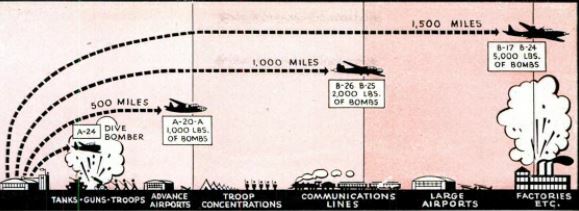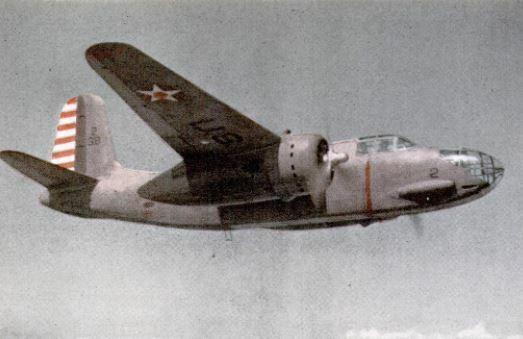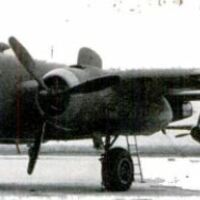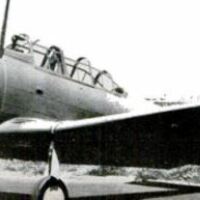-
Title (Dublin Core)
-
U.S. bombers strategy
-
Article Title and/or Image Caption (Dublin Core)
-
Title: How America Has Developed Her Sky Destroyers
-
extracted text (Extract Text)
-
THERE IS NOTHING STATIC about
military aviation in any of its phases.
It is always doing things in a new way, and
almost before one’s eyes the new ways be-
come old. But the pace of change is swift-
est in that branch least known to the pub-
lic: air support. It is so new and develop-
ing so fast that as yet it has no printed
literature. The Army's thoughts about it
are set down in 20 mimeographed pages,
mostly general theory. The rest is in the
heads of the men who are doing it.
Air support covers all forms of air action
undertaken in conjunction with ground op-
erations. The word “support” has a some-
what passive, defensive sound. It is mis-
leading. In actual practice the only way
in which the combat fiyer can help the
ground forces to which he is attached is by
attacking the ememy. When the ground
troops are stuck and on the defensive, he
attacks. When they are advancing, he at-
tacks again. And when he is not sure
whether they are coming or going, he still
attacks and keeps on attacking as long as
he can see anything on which to train his
machine guns or drop his bombs.
The support pilot's job contains a mini-
mum of routine and conventional precedent.
The long-distance bomber pilot's missions
are dangerous and complicated enough, but
at least he has a definite objective. His ob-
jective folder, with its maps and data, is
supposed to contain all he needs to know
to get his bombardier above an identifiable
target in a fixed location so-and-so many
miles away. The interceptor pilot's think-
ing has to be as fast as the flight of his
machine, but he too knows what is expected
of him—to bring down bombers which have
been reported at a given altitude on a given
axis of approach. But the support pilot
usually lacks even these few certainties of
probabilities. As he takes off, he may not
know where his target is or what it looks
like, or whether there is going to be a tar-
get at all. He may not know how far he
will fly or how long he will be gone from
his home field. He may have specific in-
structions and be unable to carry them out,
and yet his mission may be highly success-
ful. In all these things his situation is quite
different from that of other combat flyers.
In only one respect are they all alike: none
knows whether he will return.
Air support as we now know it—and it
will not be the same a year hence—is a
natural development from an earlier state
of tactical procedure. Let us take a specific
situation and see how it would have been
handled in the past and how it is handled
now. In the diagram below, C is a column,
motorized or otherwise, advancing in the
direction of a ridge or other natural ob-
struction. Here opposition is encountered
from a screened point X on the other side.
The forces at X are unknown. To attempt
a frontal assault would be very much like
passing near the brow of a hill in an auto-
mobile. There may be nothing in the way,
or there may be an oncoming truck. It is
best not to make the experiment.
Under earlier conditions, the commander
at C might have telephoned to the nearest
airdrome, A. An observation plane would
have gone up. When the observer returned
C would have got more or less complete in-
formation on the strength and disposition
of the enemy forces to guide him in his next
move. He might then have asked for an
attack plane to dislodge the obstructing
forces. But whatever action was taken,
time had been lost, and while it was being
lost X might have been busy to good ad-
vantage.
The modern tempo is faster. As soon as
serious opposition is encountered, C reports
to H, an air-support headquarters in touch
with A, and all other airdromes in the
neighborhood, and with all planes in flight.
Instead of an observation plane, a light,
fast bomber is dispatched. The crew of this
machine can make observations, perhaps
not as well as from a slow observation
plane; on the other hand they are not as
vulnerable to counterattack. But the great
advantage of the method is that the recon-
naissance bomber, as it is called, can not
only get information, but, acting on what
the Army calls air judgment, do something
about it then and there. He may, for ex-
ample, deposit a few fragmentation bombs
on X, and, observing the effects, inform H
by radio that the column can now proceed
over the ridge without too much hazard.
Of course this is a schematic and over-
simplified picture. X may have his own
airdrome, A, and C may be the one that is
attacked and dispersed. It is a question of
Who gets there first with the most bombs.
But the method is clear. It is an illustra-
tion of close support—intervention by air
on the battlefield. This is one major division
of air-support responsibility. The other is
direct support, which is defined as attack
on targets behind the battlefield, to isolate
the battlefield as far as the enemy is con-
cerned, to prevent him from bringing up
reinforcements by attacking his troop con-
centrations, interrupting his supply lines,
destroying his airdromes and planes based
thereon, etc. It is a type of bombing inter-
mediate between close support and long-
range strategic bombing, but nearer the
former.
‘The fluidity of the support bomber’s situ-
ation arises from the fact that he operates
over a battle front, and that front is some-
thing which extends over a wide area and
changes by the hour and sometimes by the
minute. His targets are where he finds them
—opportunity targets. He is on his own.
Yet free as he is to exercise his independ-
ent judgment and in fact compelled to exer-
cise it every minute, he is still a member of
a general plan and organization. He is
constantly in touch with headquarters by
radio. There is no sharp dividing line be-
tween the two ends of the radio circuit.
Teamwork on the ground means teamwork
in the air, and vice versa. At headquarters
there is an air-support officer and ground
officers—often from both the infantry and
the artillery. The location of the control
is at or near the ground command post.
Here everything can be coordinated, here
the staff work is done and the major de-
cisions made. The officer in charge is the
quarterback: he calls the plays. The play-
ers plunge and twist in their own way,
taking advantage of the openings on the
spur of the moment. It is this combination
of integrated effort and individual initiative
that wins battles.
The directing heads are on the ground
but many of the decisions are made in the
air. When, for example, a reconnaissance
pilot blows obstructing forces out of the
way, he has in effect made a decision. The
mechanized forces on the ground can go
straight ahead. When, owing to strong air
opposition, antiaircraft fire, or adverse
weather conditions, he cannot solve the
problem in such summary fashion, he may
still be able to facilitate the advance by ad-
vising a movement around the hostile units,
or some other maneuver suggested by his
observations. In any case the decisions on
the ground are made largely on the basis
of what he sees and does from his moving
vantage point above the battlefield.
The diversity of the jobs he is called on
to do is almost unlimited. Clearing away
impediments to the advance of motorized
forces is only one of them. One of his prin-
cipal missions is to take out antitank guns
to facilitate the advance of our own tank
attacks. One of the most important lessons
learned from study of the German air-
ground combat-team action is the technique
used by the Stukas in destroying antitank
guns to prepare the way for tank advances.
After a break-through the support bomber
protects the flanks of the penetrating forces.
He is active in covering parachute troops
and air infantry during transit and landing,
and in preventing the enemy from bringing
up an overwhelming force to wipe out such
detachments after they have seized a stra-
tegic position. The tendency is to extend
the operational field of support aviation
both in a geographical and a functional
sense—to assign new missions to the sup-
port groups and let them range farther
afield in performing new and old missions.
Aside from the training, experience, and
enterprise of personnel, the factors which
make for success in support aviation are
offensive weapons, including airpla es and
their armament; communications and con-
trol, and strategic location of airdromes.
The last is not the least important. In gen-
eral it is desirable to base support aircraft
close to the fighting front, so that planes
can be in action in the least possible time
after taking off. This makes the rapid con-
struction of forward or advanced airdromes
a prime necessity. New, specialized organi-
zations are being developed for this purpose
by the Corps of Engineers. Two battalions
of specially trained engineers, comprising
a force of 1,000 to 1,200 men, can in about
two weeks clear and grade an emergency
field large enough to accommodate all types
of military planes. Many such fields are re-
quired, because, quickly as they are built,
they are even more quickly damaged. For-
ward airports, and the planes based on
them, are of course a favorite target for
enemy bombers, and around each principal
field there must be auxiliary fields for dis-
persal of aircraft, so that when an attack
comes there will not be too many eggs in
any one basket.
An advance airport comprises a great
deal more than a flat, hard surface. Unless
it is to be used only as an emergency land-
ing spot, it requires gasoline stores, a power
supply, some repair facilities, and shelter
for personnel. The Army has repair trucks
for aircraft, carrying all necessary hand
tools and even light machine tools, and re-
cently flying repair shops have been added.
These are transport planes equipped with
tools for emergency repairs to enable a
damaged ship to be flown back to a repair
depot. Another auxiliary service that can-
not be dispensed with at the front is avia-
tion weather forecasting. When urgent
need arises, military fiers are willing to go
up in any kind of weather that by some
stretch of the imagination can be termed
fiyable, but the least the ground forces can
do is to keep them informed on what they
are going to encounter. Accordingly, where
tactical units go the mobile weather units
must go, to make local observations and
maintain contact with the weather stations
in the rear by teletype and radio. Ease of
communication is likewise vital to support
aviation: without an efficient communica-
tion service there can be mo effective co-
ordination between units. Visual signaling
is used to some extent for communication
with airplanes flying in close support. But
the principal contact between air and
ground is of course by radio, both voice and
telegraph. Since, flying near and over enemy
positions, the operators must expect their
messages to be monitored by hostile sta-
tions, simple secrecy codes are devised to
designate targets, time of attack, number
of planes, and the like; and these codes are
re-keyed as often as necessary. (Continued)
The planes most frequently used in sup-
port of ground forces are the A-24 dive
bomber and the A-20-A, a fast, short-range
two-engined bomber. (The A-20-A’s were
one of the features of the recent maneuvers
in the damage they inflicted on the Red and
Blue armies.) The more powerful medium
bombers of the B-25 and B-26 types also are
used in support, but for the most part it is
a light bombardment job and smaller bomb-
ers fill the bill. For close support the dive
bomber is preferred. European experience
indicates that its reign as en instrument of
terror is already over. The French may
have been stunned by the German dive
bombers; the Russians were not, and shot
down great numbers in the fall of 1941.
But, regarded as just another weapon, in-
dicated in some situations and contra-indi-
cated in others, it has its place. Its accur-
acy and maneuverability fit it for use
against precision targets and what the
Army poetically calls “fleeting targets of
opportunity.” Most free-lance bombing in
close support is of this character. The tar-
gets may be troop concentrations or move-
ments, minor field fortifications such as pill-
boxes, motorized columns, artillery in posi-
tion or in motion, etc. The effectiveness of
the attack depends on speed and surprise.
The pilot takes off, sees what he is after,
and dives at it. The usual height at the be-
ginning of the dive is around 8,000 feet. A.
descent of about 4,000 feet is usually re-
quired for the 70-degree angle favored in
this kind of operation. At an altitude be-
tween 3,000 and 4,000 feet the bombs are
released. The plane levels off
at 1,500 feet and zooms away.
In direct support horizontal
bombing is preferred. The
A-20-A affords greater bomb-
loading than diving aircraft
and has the additional advan-
tage of high speed in horizon-
tal flight. The prey of the
A-20-A is lines of communica-
tion, airdromes and aircraft
on the ground, bomb dumps,
troop concentrations, com-
mand posts, and the like. Most
of the work is done at low al-
titudes. The attack bomber is
necessarily a_grass-cutter at
times; he is not reckless, but
he works at the most effective
altitude, whatever that may
be. At very low levels he relies
on great speed relative to the
target and its defenders for
protection. By flying close to
the ground and taking advan-
tage of the cover of trees and
hills he can often surprise his
objective, and be off before ground crews
can aim their guns.
The conventional weapons of the attack
bomber are the machine gun and the bomb,
and the bomb is the more important. The
big bombs used in long-range strategic
bombing are mot suited for support avia-
tion. In this field multiple assaults with
comparatively light bombs are most effec-
tive. As far as possible, loading is limited
to a very few types. Against fortifications
demolition bombs weighing between 50 and
250 pounds are standard. Demolition bombs
operate by concussive pressure or blast,
consequently almost half the weight con-
sists of TNT. Against personnel, fragmen-
tation bombs are used. These usually come
in 30 and 100-pound sizes, and they differ
from demolition bombs in that most of the
weight is in the metal case. An ordinary
fragmentation bomb contains less than five
pounds of TNT. Such bombs will damage
light material targets, such as airplanes on
the ground, but their primary purpose is to
kill. Machine guns of .30 and .50 caliber
are similarly used against ground troops,
and also afford protection against hostile
aviation.
A new factor in close-support operations
is the growing conviction that the light
bomb is not the weapon to destroy tanks.
The problem of attacking tanks from the
air has not been solved—in fact, until some
better method is devised, there is the feel-
ing that tanks must be hit by air-borne can-
non, such as the 37-mm. carried by the P-39,
a pursuit ship. The success of these guns
in antitank operations from the air during
the recent Army maneuvers suggests the
possibility of their eventual use on the light
‘bombers.
These are the weapons. Their tactical use
is something that cannot be blueprinted. All
military operations, as planned in advance,
are in a sense a preparation for the unex-
pected. Yet there are some fairly well-de-
fined rules for the most effective use of sup-
port aviation. These relate mainly to the
optimum number of planes for a given op-
eration. Against precision targets and in
close support the single airplane is most
adaptable and gives the best results. It is
likewise effective against linear targets, such
as marching or motorized columns, but usu-
ally such objectives are important enough
to warrant the use of small formations—
loose three or four-plane elements. Such
columns are very inviting targets for sup-
port bombers. The attacking units approach
obliquely, turn, and fly over the objective
only during actual delivery of offensive fire.
The conventional method is for the leading
plane to line up the target with the gun
sight, nose down and deliver forward ma-
chine-gun fire, level off, and release bomb
loading. The following planes repeat this
procedure on other portions of the column.
Usually a single pass is sufficient to obtain
effective hits. When defensive fire is heavy
it is inadvisable to make more than one
pass; the defenders are apt to be more ac-
curate in thelr aim the second time around.
Larger formations, up to squadron size
(12 to 15 planes) may be used against area
targets. A squadron is about as much as
one commander can handle in the air, and
the target has to be worth while to warrant
80 much risk and expenditure of material.
In these cases a bombing pattern is worked
out in advance, with each plane in the squad-
ron assigned to a specific portion of the area.
The altitude is likely to be comparatively
high and the bombsight is necessary for ac-
curate aim.
If, in accordance with present plans, we
are to have an air force of 500,000 men, the
support groups will have to be a great deal
larger than they are now. The present air
support is good —what there is of it. Train-
ing additional personnel will be a consider-
able job in itself. The problem is one of joint
training. Air-support fliers must have at
least a fair understanding of ground-force
operations and dispositions, besides the tech-
nique of air attack, communication, map
and photograph reading, and all the other
subjects with which they must be familiar.
The ground forces, for their part, must learn
the potentialities and limitations of combat
aviation, ground reconnaissance with a view
to selecting targets for aviation, signaling to
aircrat, and so on. Above all, once the ele-
mentary stages have been passed, there
must be joint training in maneuvers. The
soldier, like other men, learns mainly by
practicing what he has been taught. The
frequent use of ground officers as observers
from aircraft, and of air officers as observers
with ground forces, is vital to progress in
this field. And that progress is vital to the
Army,
-
Contributor (Dublin Core)
-
Carl Dreher (Article Writer)
-
Language (Dublin Core)
-
eng
-
Date Issued (Dublin Core)
-
1942-02
-
pages (Bibliographic Ontology)
-
82-89
-
Rights (Dublin Core)
-
Public Domain (Google Digitized)
-
Archived by (Dublin Core)
-
Roberto Meneghetti
-
Marco Bortolami (editor)
 Popular Science Monthly, v. 140, n. 2, 1942
Popular Science Monthly, v. 140, n. 2, 1942








